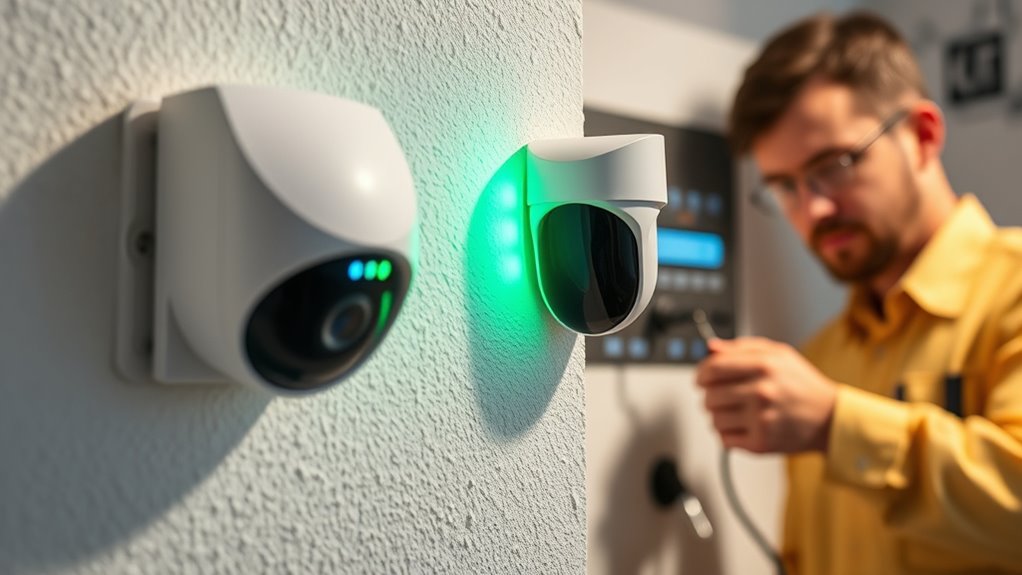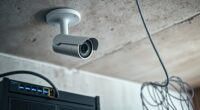To reduce false alarms without sacrificing sensitivity, you should use advanced sensor fusion and multi-threshold detection systems that analyze different signals simultaneously. Regular maintenance and calibration guarantee sensors stay accurate and less prone to environmental interference. Implementing machine learning algorithms can help your system learn and adapt over time, filtering out non-threat triggers. Proper placement and user training further minimize errors. Keep exploring for more strategies to optimize your security setup effectively.
Key Takeaways
- Implement multi-threshold detection systems to differentiate between benign disturbances and genuine threats.
- Utilize sensor fusion to combine data from multiple sources for more accurate alarm validation.
- Regularly calibrate and maintain sensors to ensure optimal sensitivity and reduce noise-induced false triggers.
- Incorporate AI and machine learning algorithms to analyze patterns and adapt sensitivity over time.
- Properly position sensors and minimize environmental interference to prevent false alarms without lowering sensitivity.
Understanding the Causes of False Alarms

Have you ever wondered why security systems trigger false alarms? Often, it’s due to sensor noise or environmental interference. Sensor noise occurs when sensors pick up minor fluctuations that aren’t actual threats, like vibrations or electrical interference. Environmental factors such as heavy rain, strong winds, or nearby moving objects can also cause false triggers. These disturbances trick the system into thinking there’s an intrusion when there isn’t one. Understanding these causes helps you recognize that not all alarms signal real danger. By identifying sources like sensor noise and environmental interference, you can take steps to minimize their effects. This knowledge empowers you to adjust your system settings or install protective measures, reducing false alarms without sacrificing security sensitivity.
Advanced Sensor Technologies for Improved Accuracy

Advancements in sensor technology have led to more accurate and reliable security systems. By integrating sensor fusion, multiple data sources combine to provide a clearer picture, reducing false alarms. Enhanced sensors now excel at anomaly detection, distinguishing genuine threats from background noise. Imagine a system that cross-references motion, sound, and heat sensors seamlessly:
| Sensor Type | Function | Benefit |
|---|---|---|
| Motion Sensor | Detects movement | Reduces false triggers |
| Acoustic Sensor | Monitors sound patterns | Identifies anomalies |
| Thermal Sensor | Measures heat signatures | Confirms presence or absence |
This synergy ensures alerts are precise, prioritizing true threats without sacrificing sensitivity. Advanced sensor technologies, through sensor fusion and anomaly detection, revolutionize alarm accuracy.
Additionally, integrating Self Watering Plant Pots concepts can inspire innovations in sensor-based systems that automatically maintain optimal conditions.
Implementing Multi-Threshold Detection Systems

How can security systems reduce false alarms without sacrificing sensitivity? Implementing multi-threshold detection systems is an effective approach. By setting different thresholds for various sensor signals, you can optimize sensitivity levels for each detection type. Threshold optimization allows you to distinguish true threats from benign events more accurately, reducing false alarm mitigation issues. Instead of relying on a single alarm trigger, multi-threshold systems analyze multiple parameters simultaneously, filtering out minor fluctuations that might otherwise cause false alarms. This layered approach ensures genuine threats activate alerts while harmless activities stay below detection levels. Additionally, understanding sensor calibration is crucial for maintaining the accuracy of detection thresholds. As a result, you enhance overall system reliability, minimize unnecessary disruptions, and maintain high sensitivity to real security breaches. Multi-threshold detection systems are a practical solution for better false alarm management.
Leveraging Machine Learning and AI for False Alarm Reduction

Building on multi-threshold detection systems, integrating machine learning and AI offers a powerful way to further reduce false alarms. These technologies use predictive analytics to identify patterns and distinguish true positives from false signals. Data fusion combines inputs from multiple sensors, enhancing decision accuracy. Machine learning models can adapt over time, improving alarm reliability and minimizing unnecessary alerts. To visualize this, consider the following:
| Technology | Function | Benefit |
|---|---|---|
| Predictive analytics | Analyzes historical data for pattern detection | Reduces false positives by predicting likely events |
| Data fusion | Merges sensor inputs into a cohesive view | Enhances accuracy and reduces false alarms |
| AI algorithms | Learns and improves from new data | Continuously refines alarm precision |
Additionally, understanding the sensor integration process ensures that data from various sources is effectively combined for optimal detection.
Leveraging these tools helps you maintain sensitivity while cutting false alarms efficiently.
Regular Maintenance and System Calibration Practices

Regular maintenance and system calibration are essential for ensuring your alarm systems operate accurately and reliably. Proper sensor placement is critical; verify sensors are positioned to cover the intended area without false triggers caused by environmental factors or obstructions. Regularly inspect sensors to identify dust, debris, or damage that could impair performance. Calibration aligns system sensitivity with real-world conditions, reducing false alarms while maintaining detection capabilities. Implement an alarm hierarchy that prioritizes alerts based on severity, helping to prevent unnecessary responses. Periodic testing of each component guarantees the system functions as intended, and adjustments can be made as conditions change. Staying informed about Gold IRA rollovers can also provide alternative security options for your assets, reinforcing overall safety. By staying proactive with maintenance and calibration, you keep false alarms in check without sacrificing the system’s sensitivity or effectiveness.
User Training and Operational Best Practices

Proper user training and adherence to operational best practices are key to minimizing false alarms and ensuring your alarm system functions effectively. When you focus on user engagement, you improve how operators respond and follow procedures, reducing errors. To optimize protocols, consider these steps:
- Regularly train staff on system features and updates.
- Establish clear alarm response procedures for different scenarios.
- Encourage users to verify alarms before responding.
- Review and update operational protocols periodically.
- Emphasize the importance of user training to maintain system integrity and performance.
Frequently Asked Questions
How Do Environmental Factors Influence False Alarm Rates?
Environmental factors considerably influence false alarm rates. You should regularly check sensor calibration to guarantee accuracy, as miscalibrated sensors may trigger false alarms. Additionally, ambient noise can cause sensors to react falsely, especially in noisy environments. By monitoring and adjusting for these factors, you can reduce false alarms without losing sensitivity. Staying vigilant about environmental conditions helps maintain ideal sensor performance and minimizes unnecessary alerts.
Can False Alarms Be Reduced Without Increasing System Costs?
You can diminish false alarms without increasing costs by focusing on proper sensor calibration and implementing alarm verification processes. Regular calibration ensures sensors accurately detect true events, while alarm verification confirms the event before alerting you. These steps enhance system reliability without additional expenses, helping you maintain sensitivity while minimizing false alarms. Investing time in calibration and verification optimizes your existing system’s performance effectively and affordably.
What Role Do User Behaviors Play in False Alarm Occurrences?
Did you know that user behavior accounts for up to 80% of false alarms? Your actions substantially influence alarm accuracy, often caused by improper responses or neglecting system alerts. By prioritizing user training, you can teach correct procedures, reducing alarm fatigue and preventing unnecessary triggers. When you understand how your behavior affects alarms, you help maintain system sensitivity without increasing false alarms, ensuring reliable security and safety.
Are There Legal or Compliance Issues Related to False Alarm Reduction?
You need to be aware that reducing false alarms raises legal compliance and data privacy concerns. Ensuring that your alarm systems meet regulations helps avoid penalties, while protecting user data maintains trust and privacy rights. You should regularly review your security protocols, stay updated on evolving laws, and implement safeguards that balance alarm accuracy with legal and privacy obligations. Failing to do so could expose you to legal actions or data breaches.
How Do False Alarm Reduction Strategies Vary Across Different Industries?
Imagine you’re in a different era—like the Renaissance—applying modern methods. You’ll find false alarm reduction strategies vary widely across industries. In security, you optimize algorithms to diminish false positives, while in healthcare, user training guarantees staff correctly interpret alerts. Each sector tailors its approach to balance sensitivity and accuracy, ensuring responses are swift but not overwhelming, making your system both reliable and efficient across different environments.
Conclusion
So, next time your alarm screams wolf, remember—it’s not always the system’s fault. With smarter sensors, AI, and a bit of upkeep, you can keep false alarms at bay without turning into a nervous wreck. Just don’t forget to train your team and stay calibrated—after all, you don’t want to be the person who causes chaos over a false call. Because nothing says “trust me” like a well-tuned alarm system.









